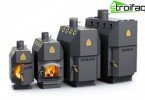Garage Heaters
Keeping the car in the garage in winter frees its owner from many problems: you won’t have to dig out the car from the snowdrift caused during the night, it warms up faster, and there will be no problems when starting the cold engine. But even in a separate garage or in a garage box in a severe frost, a car can also freeze if it does not have a heating system. Too warm a garage for a car is not useful: the recommended winter temperature regime is + 5 ° C. Unfortunately, in our country so far there are very few garages equipped with a unified stationary heating system with the cottage, as is customary in the west, and the various microclimate optimal for a car are provided by various heaters for a temporary heating garage.
Content
- Types of fuel for heaters
- Solid fuel units
- Garage gas heaters
- Electric heaters: types
- Dielectric and spiral convectors
- Portable oil radiators
- Electric heat guns
- Infrared Garage Heaters
Types of fuel for heaters
It should be noted that the industry does not produce appliances designed specifically for heating garages. Meanwhile, no matter how well the garage box is insulated and sealed, ventilation in it, as a rule, is not ideal and can effectively dry air from excessive moisture, which is inevitable when snow and ice melt from the surface of the machine. Yes, and it is more convenient for the car owner to change oil warmly or perform minor repairs of his vehicle. Therefore, for the temporary heating of garages, portable heating appliances have been successfully used, designed for residential and non-residential premises for various purposes, the fuel for which can be:
- firewood;
- gas;
- electricity;
- diesel fuel;
- used oil.
Solid fuel units
Mobile solid fuel heaters, ranging from archaic artisanal stove stoves to modern stoves from domestic and foreign manufacturers, are often the only available means of heating garages that are not supplied with electricity. True home-made stoves-potbelly stoves do not always meet safety standards, and heating appliances like Bullerjan are frankly expensive.
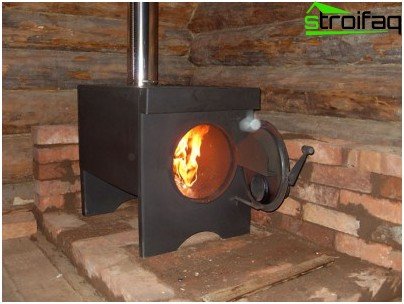
Compact heater for a wood-fired garage; an exhaust pipe is needed to install it
With the simplicity of the device, solid fuel furnaces are quite difficult to install: an exhaust pipe is needed. The main disadvantage when using this type of heaters is that the device cannot be left unattended: you need to constantly add fuel, otherwise it will fade. The need for periodic cleaning of the chimney from soot and regular removal of ash also causes a lot of inconvenience.
The obvious advantage of this type of heaters is the versatility and availability of fuels (coal, firewood, wood waste and sawdust). Coal is effective, but not cheap, and to store a supply of firewood requires free space, which is not too much in the garage.
Garage gas heaters
Trunk gas, as a rule, is not brought to garages, even if it is brought to the house. This is both expensive and dangerous: any gas leak in the vicinity of electricity and combustible substances in an unattended room is fraught with explosion. However, in the distance from “civilization” portable gas heaters for the garage and other rooms running on liquefied gas may well solve the problem of temporary heating. Heat sources heating air in heaters of this type can be convectors or special ceramic honeycomb screens.
The advantages of gas heaters include:
- very fast heating of the room;
- ease of transportation and mobility;
- low heating costs;
- independence from electricity.
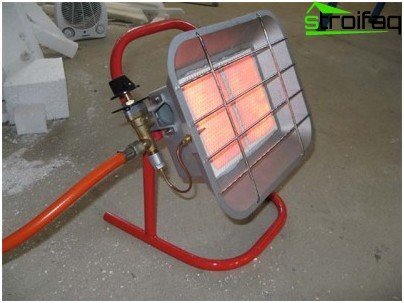
Portable gas heater for garage
Installation, repair and maintenance of gas convectors should be carried out only by a specialist, and their safe operation is possible only with the arrangement of a gas outlet for the output of combustion products. The condition for the safety of portable gas heaters is very good ventilation, which is not always feasible in garages.
Electric heaters: types
Electricity, main or autonomous, is the most affordable source of energy, and therefore the electric heater for the garage is most often used for temporary heating. The following types of portable electric heating equipment are available:
- electric convectors;
- oil electric radiators;
- portable electric heat guns;
- infrared heaters.
Dielectric and spiral convectors
The heating element of the electroconvector, on which the efficiency and some of the nuances of its operation depend, can serve
- dielectric plate;
- spiral construction.
The dielectric plate is located inside the aluminum case and, when heated, transfers heat not only to the metal of the case, but also to the surrounding air. According to the law of natural convection, light warmed air rises, displacing heavier cold air down. A small room warms up very quickly. Convection with a dielectric plate is very good in living rooms, since they do not dry the air at all and, thanks to the protective case, are safe in rooms with high humidity.
Spiral electric convectors, despite the fact that they are considered an obsolete design, are more preferable for temporary heating of the garage, where the fight against high humidity is one of their main functions.
Portable oil radiators
Mobile, compact, inexpensive and safe oil heaters from well-known manufacturers are convenient and popular. Compared with other devices, they heat up the room for too long, which is not always suitable for a garage. In addition, oil-filled heaters consume a lot of electricity and therefore their use is expensive. The very high cost of operation minimizes all the undeniable advantages of traditional electrical appliances for temporary garage heating.
Electric heat guns
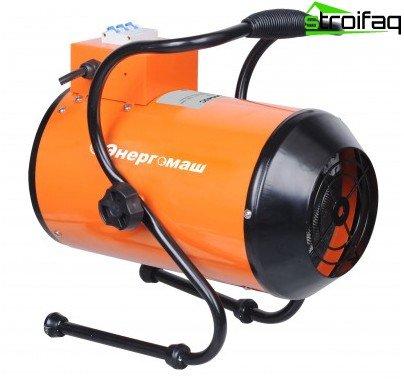
Electric fan heater heats and dries air quickly
The design of the device is a professional powerful fan in a very durable metal case. The heat from the heating element – TENA is very quickly spread by the fan in the garage room. The device can be used for heating, drying and forced ventilation of any room.
Infrared Garage Heaters
Among electric and gas heating appliances, infrared garage heaters occupy a special niche of their own. They are relatively new to everyday life, and were first used by Ford to dry car bodies after painting..
The source of infrared radiation in heaters of this type is a quartz glass or glass-ceramic element heated by electricity or gas. Unlike traditional heaters, an infrared heater like the sun heats objects that are subject to a radiation flux, and they, in turn, warm the surrounding air.
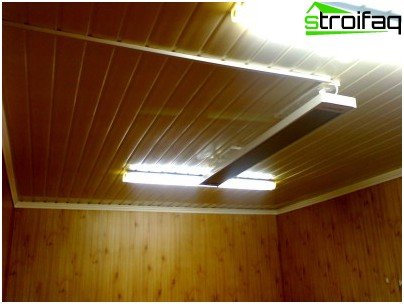
Ceiling infrared heater does not take up useful space, which is always insufficient in garages
Infrared heaters are available for wall or ceiling mounting, and their installation must comply with the manufacturer’s recommendations: height from the floor is at least 180 cm, and from the heated surface at least 70 cm. Never use infrared heat sources near flammable and explosive substances and it is undesirable to heat them rooms with high humidity, such as car washes. Infrared heaters heat the room almost 3 times faster than traditional heaters, do not cause natural convection of air, drafts and have many advantages:
- profitability – consume very little electricity and are effective for local heating of small areas in spacious rooms;
- affordable prices;
- mobility – convenient to carry, easily fit in the trunk of a car;
- environmental safety – the operation of the device is not accompanied by the release of combustion products and the occurrence of harmful electromagnetic fields;
- durability – designed for 25 years of service, do not contain wearing parts in contact with each other
Potentially infrared heating devices can be used as not only temporary, but also constant heating of the garage throughout the winter season, but it is not yet known how prolonged infrared radiation can affect the condition of the car’s paintwork.
Oil heaters
Indirect heaters operating on kerosene, diesel fuel and even used engine oil are very effective for temporarily heating the garage: even a not very well insulated garage such a heater can warm up well in a few minutes. The device is capable of providing a power of 10-20 kW, consuming very little electricity, which it needs only to drive a fan. Thermal energy from burning liquid fuel heats the air passing through the space of the heat exchanger of the heat gun and through the nozzle directs it to the room, and the combustion products are removed from the room through the chimney. Advantages of a liquid fuel heat gun:
- environmental Safety;
- high speed garage heating;
- very low power consumption;
- the possibility of using spent engine oil as fuel;
- mobility: the heater on wheels easily moves anywhere in the room.
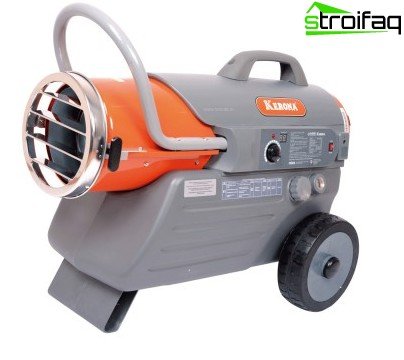
Diesel powered heat gun
The main disadvantage of a liquid fuel heat gun is the continuation of its main advantage – the need to equip a chimney for the output of combustion products.
Regardless of the type of heater, the effectiveness of heating a garage depends, first of all, on the quality of its thermal insulation, and compliance with the recommendations on the installation and operation of the heating device and the necessary precautions and safety measures will eliminate possible troubles.


